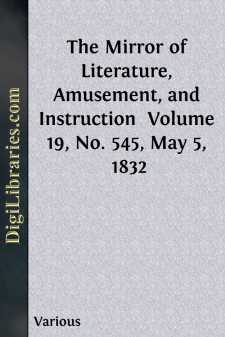Categories
- Antiques & Collectibles 13
- Architecture 36
- Art 48
- Bibles 22
- Biography & Autobiography 813
- Body, Mind & Spirit 142
- Business & Economics 28
- Children's Books 14
- Children's Fiction 11
- Computers 4
- Cooking 94
- Crafts & Hobbies 4
- Drama 346
- Education 46
- Family & Relationships 57
- Fiction 11829
- Games 19
- Gardening 17
- Health & Fitness 34
- History 1377
- House & Home 1
- Humor 147
- Juvenile Fiction 1873
- Juvenile Nonfiction 202
- Language Arts & Disciplines 88
- Law 16
- Literary Collections 686
- Literary Criticism 179
- Mathematics 13
- Medical 41
- Music 40
- Nature 179
- Non-Classifiable 1768
- Performing Arts 7
- Periodicals 1453
- Philosophy 64
- Photography 2
- Poetry 896
- Political Science 203
- Psychology 42
- Reference 154
- Religion 513
- Science 126
- Self-Help 84
- Social Science 81
- Sports & Recreation 34
- Study Aids 3
- Technology & Engineering 59
- Transportation 23
- Travel 463
- True Crime 29
The Mirror of Literature, Amusement, and Instruction Volume 19, No. 545, May 5, 1832
by: Various
Categories:
Description:
Excerpt
ZOOLOGICAL GARDENS, REGENTS'S PARK.
Emu EnclosurePelican EnclosureAviary for Small BirdsOur strolls to this scene of intellectual amusement, (or "the gardens with a long name," as Lord Mulgrave's new heroine naively calls them,) are neither few nor far between. The acquaintance is of some standing, since The Mirror was the first journal that contained any pictorial representation of these Gardens, or any connected notice of the animals. At that time the Society had not published their "List," and our twopenny guide was common in the hands of visiters. We do not ask for the thanks of the Council in contributing to their annual receipts, now usually amounting to £10,000.: we were studying the interest of our readers, which uniformly brings its own reward. The first of the present illustrations is the Emu Enclosure, in the old Garden. Several broods of Emus have been reared by the Society at their Farm at Kingston Hill; and some of the year's birds are usually exhibited here. Next is the Pelican Enclosure, containing a house of mimic rock-work, and a capacious tank of water, the favourite element of the Pelican. One pair in mature plumage, and a second pair, supposed to be the young of the same species, are exhibited. The third Cut is the Aviary for small and middle-sized birds, at the north-eastern corner of the Garden. Here are kept various British Birds, as the different species of Crows and Song Birds. The bamboo ornaments of the building are not, therefore, of the appropriate character that we so much admire elsewhere in the Gardens.
"Happy Jerry"The individual with this felicitous soubriquet, was a specimen of the great Mandrill Baboon, in its adult state, the Papio Maimon of Geoffrey, and the Cynocephalus Maimon of Desmarest. It is a native of the Gold Coast and Guinea, in Africa, where whole droves of them often plunder the orchards and vineyards. Their colours are greyish brown, inclining to olive above; the cheeks are blue and furrowed, and the chin has a sharp-pointed orange beard; the nose grows red, especially towards the end, where it becomes of a bright scarlet. Such are, however, only the colours of the adult animal; the young differs materially, on which account it has been considered by naturalists as a distinct species.
Jerry is now a member of death's "antic court," but his necrology may be interesting to the reader. Mr. Cross describes him as "from on board a slave vessel that had been captured off the Gold Coast, in the year 1815," when he was supposed to be three years old. He was landed at Bristol, and was there purchased by the proprietor of a travelling menagerie, who kept him for some years, and taught him the various accomplishments he after excelled in, as sitting in a chair, smoking, drinking grog, &c.; probably he required but little tuition in the latter; since we find a fondness for fermented liquors numbered among his habits by the biographers of his species. In 1828, Jerry was purchased by Mr. Cross, and exhibited at the King's Mews, when he appeared in full vigour, and attracted a large number of daily visitors....












